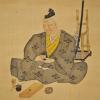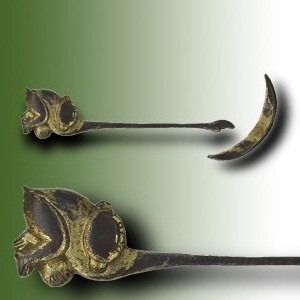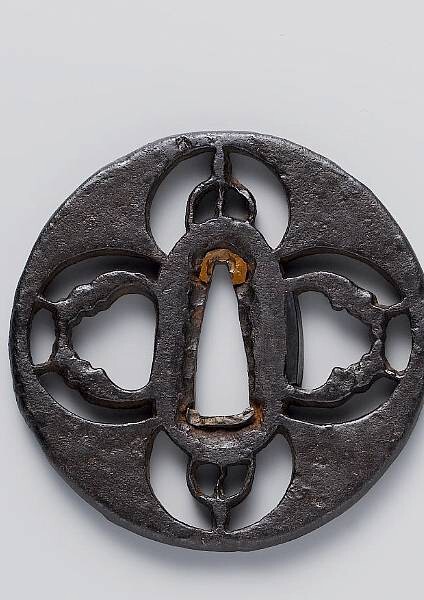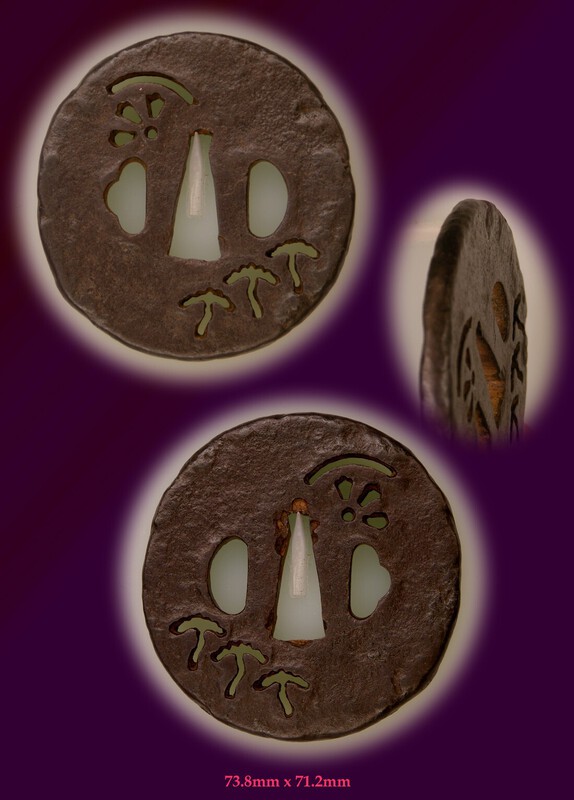-
Posts
110 -
Joined
-
Last visited
-
Days Won
1
Content Type
Profiles
Forums
Events
Store
Downloads
Gallery
Everything posted by Tim Evans
-
This tsuba is similar to number 42 in the Yagyu catalog that was hand copied by Robert Haynes. The design in the catalog is called "distant pines". I agree this is similar, but depicts flopped over mushrooms instead, so a later variant. I am thinking the flopped over mushroom is a Buddhist comment on impermanence. "Here is a softmetal example on a Higo kojiri. There is a distant pines version in Sasano's silver book on page 201.
-

Mumei Kanayama tsuba that point to a specific tsubako
Tim Evans replied to Iaido dude's topic in Tosogu
Interesting observation on those poetic and atmospheric pictorial kanayama being kierei-sabi, I had not thought of them that way before. Enshu was the Tea Master to the Shogun Tokugawa Iemitsu, where we see the Tokugawa-driven shift in Buke education away from Buddhism to Confucianism, following the Chinese scholar-warrior model. This aligns with ther rise of Kaneie (also kierei-sabi), which this scholarship I recently discovered, (published in the JSS/US Newsletter by Arnold Frenzel) puts Kaneie in the early Edo period, much later than what has been supposed by other researchers. https://www.jssus.org/1975_Bulletin_Part1_Kaneiye_Tsuba__Sword_Etiquette_and_Care_Japanese_Lacquer_Swords_Travels_Oshigata_Artist_Seals.pdf -

Mumei Kanayama tsuba that point to a specific tsubako
Tim Evans replied to Iaido dude's topic in Tosogu
I don't think these unknown tsuba smiths can be identified to a named person, but I think it is possible to sort some of these mumei ji-sukashi tsuba of this period into groups or shops that show common detail characteristics. -

Mumei Kanayama tsuba that point to a specific tsubako
Tim Evans replied to Iaido dude's topic in Tosogu
I think it was more of a subtle change. The Tea Masters were a big influence at the upper end of Buke culture and influenced Buke taste and aesthetic choices. Rikyu promoted Wabi tea, which was an egalitarian and transformatory experience. Tsuba that reflect the transitory and transformatory, like Kanayama and Yamakichibe, are about process, mystery and no fixed identity. These tsuba show process through incompleteness, which is usually mistaken for flaw and imperfection. You can think about it as a Buddhist artform or aesthetic language. Oribe used Wabi as a base of taste, but developed Daimyo tea, which was a more hierarchical and confirmatory experience. Enshu continued developing Daimyo Tea and introduced Kirei sabi, which was restrained, rustic but very elegant. For tsuba examples, think of tsuba like Jingo or Nishigaki or Akasaka. Some lumpiness but more sophisticated and artistic. For more information on the transformatory or confirmatory uses of chanoyu, this essay by Herbert Plutschow is a place to start. https://anthropoetics.ucla.edu/ap0501/tea/ -

Mumei Kanayama tsuba that point to a specific tsubako
Tim Evans replied to Iaido dude's topic in Tosogu
Steve and I have discussed this at length. We think that the deliberately lumpy guards align with the popularity of Tea ceramic aesthetics, starting with the Tea Master Rikyu, (Wabi Tea aesthetics), to Furuta Oribe, (Kabuki aesthetics), but rustic guards started to go out of fashion with Kobori Enshu (Kirei Sabi aesthetics). -
The Taiko, Toyotomi Hideyoshi ruled during the Momoyama period, which was known for the gorgeous personal koshirae of the Daimyo. The koshirae of the Daimyo who were the direct vassals of Hideyoshi still exist, and the lacquer on the saya often used a lot of gold leaf, gold lacquer, red lacquer, etc. The formal court koshirae (kami-shimo-zashi) with plain black lacquered saya was a regulation of the the later Tokugawa Shogunate.
-

Mumei Kanayama tsuba that point to a specific tsubako
Tim Evans replied to Iaido dude's topic in Tosogu
There are 3 types of shop marks I commonly see on Kanayama tsuba. A bevel around the nakagoana on the front. In untouched examples the bevels are smoothly cut, but in others the bevel is dented from refitting. Another type has rectangular punch marks surrounding the nakagoana on the back. These may be layout marks. A third type has small dings at the corners of the nakagoana on the back, also probably layout marks. -
There is not a simple answer to this question, it really depends on time period and the status of the buyer or user. There are very fancy, expensive tsuba made about Meiji period, that were made as standalone objects to be admired in their boxes. Possibly some were made to order, some possibly made on spec. Prior to that, when swords were worn, then the design was about the koshirae as a whole, not just the tsuba. Here is an article by Fred Weissberg about a high end Edo period koshirae that still has the documentation and correspondence associated with the design process. https://nihonto.com/nakai-koshirae/ This is very rare! These high end koshirae quite often had an integrated poetic or literary theme. There were obviously koshirae below this level of quality and customization. There were koshirae shops that could put together a koshirae based on personal taste and budget, either from tosogu provided by the owner or pieces sourced by or made by the shop. This is an art form and service that still exists today. There are some very old, documented, intact tachi koshirae. These follow very formal design rules and do not show much individuality. Sometimes there is documentation on who owned them. Then there are what I call arsenal koshirae. These were mounted swords put together from whatever was handy and provided as needed to low level warriors by Daimyo or by shrines and temples. There was an exhibition of historically preserved koshirae by the NBTHK which produced a catalog called Uchigatana (no) Koshirae. This illustrates items from Daimyo level koshirae to arsenal type swords. Interestingly many of the older Daimyo koshirae have previously used tsuba.
-
Here is another one held in place with a strip of leather. Maybe vintage but probably not antique. As far as tsuba initially made to fit bokuto, Steve Waszak had one made by a contemporary Japanese tsuba smith with the ana clearly designed for bokuto. All the antique tsuba I have seen with big holes appear to have been modified later rather than made that way.
-
Looks like a nice example. Under the FAQ System at the top, read through the sword maintenance and handling articles in order to keep the blade in good condition. It looks like the silk wrap is a bit frayed. This can be mitigated by a small amount of white glue applied to the frayed bits.
-
Omura Sumitada of Hizen was the first Christian Daimyo, baptized as Bartholomew. He opened the port of what became Nagasaki to foreign trade. Interestingly, a kamon of the Omura clan looks a lot like these tsuba. Oda Nobunaga was tolerant of the new religion and allowed the Jesuits and Franciscans to build churches and baptize converts, so the faith was practiced openly. I suspect these tsuba were worn by Omura Samurai.
-
Translation of the the book Owari To Mikawa no Tanko lists Shigehiro as a maker of Shiire tsuba, or, tsuba for stock. He is listed in the Haynes Index as H 08258, but no other information other than what has already been posted. If you don't mind my asking, how did it come to you? I think it is interesting to track how these items move around. . .
-
The Modern Reader's Japanese-English Character Dictionary by Andrew N. Nelson has a guide in the front to help locate kanji by stroke count and radical, which then refers you to the page where there are kanji with those characteristics translated to English. It is my go-to reference for deciphering kanji.
-

Menuki Hyotan Namazu ("Catching a catfish with a gourd")
Tim Evans replied to Iaido dude's topic in Tosogu
Niten Ryu is one of the Koryu (traditional martial arts). This is a very deep subject. Unlike Gendai budo, the Koryu are still considered to be closely held martial skills that are not popularized to the public. You will not see much promotion, commercialization, monetization or recruitment by Koryu organizations. To learn more, this site is a good place to start. https://koryu.com/ -

Menuki Hyotan Namazu ("Catching a catfish with a gourd")
Tim Evans replied to Iaido dude's topic in Tosogu
The theme of moon and monkey is often seen on Niten Ichi Ryu koshirae, but as kodugu not tsuba. The iron moon and monkey tsuba have always puzzled me since they don't look Higo and are normally put into the "Shoami" bucket by the Japanese. Here are some examples of moon and monkey menuki. Also another menuki set in an article by Fred Weissberg, at the bottom. https://nihonto.com/miyamoto-musashi / And a set of kurikata and soritsuno in another article by Fred. https://nihonto.com/10-1-20/ The cult of Musashi has always been strong and continues today. I suspect most of the later Edo period Niten koshirae were commissioned by the Noda-Ha (Kumamoto branch) of Niten Ichi Ryu Hyoho, but also could have been created by the Edo Higo (Kumagai) kinko-shi for members of the two Edo branches of Niten Ichi Ryu Hyoho. -

Assistance with description of motif element
Tim Evans replied to Steve Waszak's topic in Translation Assistance
On the first tsuba, I think the device on the left is a Kamon of three kiku blossoms. This is a kamon of the Kusunoki family. Kusunoki Masatora was an official in the Oda Nobunaga administration (Papinot page 335). Here is another example. -

Itomaki-No-Tachi Koshirae (How do I match a tachi blade?)
Tim Evans replied to Iaido dude's topic in Nihonto
It looks like all the seppa are stacked between the fuchi and the tsuba. It appears to be four seppa, I think should be two in front of the tsuba and two behind. -
Yes, a tsunagi can be reverse engineered. There are US based sayashi who can do that if you don't want to try it yourself. Do you have all the parts, such as the seppa and mekugi?
-

Itomaki-No-Tachi Koshirae (How do I match a tachi blade?)
Tim Evans replied to Iaido dude's topic in Nihonto
There is a readily available book called The Craft of the Japanese Sword which is a good overview of the process of making a gendaito, handing off to the polisher, handing off to the habaki maker and then to the saya maker. It describes how these artisans work together to create the finished product. I mentioned finding a reliable agent, someone who either lives in Japan or travels there regularly and is in the sword business. I have seen two or three recommended here on NMB, but one I recall is Paul Martin. He has a website with a page on how to commission a new sword. -

Itomaki-No-Tachi Koshirae (How do I match a tachi blade?)
Tim Evans replied to Iaido dude's topic in Nihonto
There are members here that are very familiar with the Gendaito scene. Chris Bowen comes to mind. Another consideration is the habaki. Does the tsunagi have a metal habaki or wood? If wood, then a habaki will need to be made to fit both the blade and the saya. Maybe find a reliable agent to manage the work in Japan? Tasks - Make the sword, polish the sword (Maybe not top grade polish if going the be kept in old koshirae). Make habaki (if needed), have a sayashi fit everything together correctly. You probably want a shirasaya made to have the blade shipped. Also coordinate between all of the artisans and getting the completed sword documented and sent back to you. -

Itomaki-No-Tachi Koshirae (How do I match a tachi blade?)
Tim Evans replied to Iaido dude's topic in Nihonto
If the koshirae has a tsunagi, then a sword smith can use it to make a sword blade to fit. -
Some images I have collected over the years of suspected Ono tsuba. I don't own them nor have I seen them in hand, so feel free to disagree.
-
Bob Haynes interviews, well worth watching. BIG posted this link in the Events section: https://www.militaria.co.za/nmb/topic/50544-robert-haynes/ Or direct link for all 5 videos: https://ificah.de/interviews/
-
A good start. Quite often a cleaning project will look worse before it gets better, so that requires a long term commitment. There is a detailed description of the iron tsuba cleaning and patina growth process in Sasano's "gold" book: Sasano, Masayuki. Sukashi Tsuba. London, England: Robert G. Sawers, 1974. It may be possible for you to find a copy through the local library if you want to read it first. As Sasano states, after removing the red rust the next step is to stimulate the formation of black rust, so avoid lotions or oily perspirations that would shut out air and interfere with the oxidation process. A wash with mild soap and water is ok to degrease and get off any remaining loose red rust. Setting it in a sunny window is helpful because adding some mild heat will increase the rate of oxidation.
-
An interesting comment in the Varshavsky collection reference from Dale. Provenance: Robert E. Haynes, Mark Weisman. This is what shibuiswords.com says about this tsuba: Just for context, Robert (Bob) Haynes is one of the foremost Japanese sword fittings authorities in the US, having studied with Dr. Kazutaro Torigoye in Japan in the 1960's. There is a lot of useful tsuba material by Bob on the Shibui Swords site, Elliott and Bob collaborate a lot since they live near each other.



















